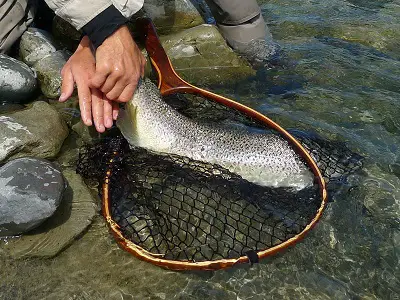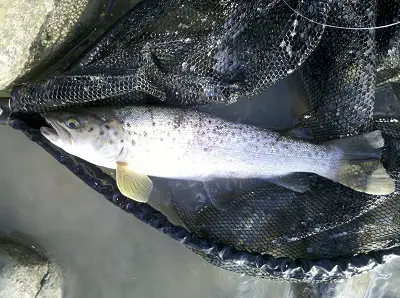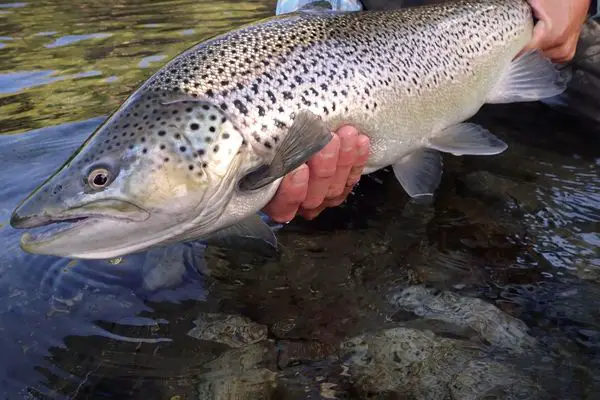Every autumn sea run brown trout enter large rivers and estuaries. My local rivers are blessed with sizeable runs of sea run brown trout.
Every spring they chase baitfish into the estuaries and the lower pools of the rivers. They are hungry and trying to recover condition lost over the harsh winter months.
In the fall they return to the freshwater and head on their spawning migration.
These trout grow large and powerful on the plentiful prey of the lower river. There they have feasted upon various baitfish and even mud crabs. Trout are a generalist, they rarely turn down an easy meal.
The longer the sea trout have been in the river, and the further they push upstream, the more closely they resemble resident fish. Their bright silver scales fade, turning brown. Their diet also changes, from baitfish dominated to aquatic insects that are the bread and butter for river fish.
Once in the river, smaller sea run trout often move around in age group shoals. If you can find such a group, the fishing can be intense.
One spring morning when I was working next to a river. I spied a large gathering of pan size sea run trout. They were holding mere yards from the bank. Maybe they recently entered the river, but they were not the smartest trout and not at all line shy. They hungrily grabbed at every streamer I presented, often several trout following at a time. In my 15 minute morning break, I landed five 10 inch long fish.
For the rest of the morning, I glanced back occasionally, and they had not moved on. They must have really liked that spot. The spot the sea runs were holding was just above the first riffle in the lower river. These baitfish shoals swim upstream, clinging to the shoreline where the current is at its slowest. I guess the sea run trout knew that so the shoal positioned itself to intercept any baitfish the moment they hit still water. I have never encountered such a gathering again.

Best locations to target sea runs
River Mouth
The river mouth or bar is a popular gathering spot for fish and anglers. It is where many trout fishermen first head in the search of sea run trout. But, in my experience river mouth fishing for trout is tough, doubly so when using a fly rod due to lack of casting distance.
The mixing of salt and freshwater usually attracts many baitfish, and where there is bait fish, there are predatory fish like trout which gather to feed upon any baitfish which might become disoriented in the surf.
I have spent hundreds of hours fishing river mouths. In that time, mostly fishing during the day I have caught only five sea-run trout. I rarely see others catching them also. In my experience, it is best to target other species like salmon at the mouth and any trout is just a lucky bonus.
Sea run trout often rest and feed around the first riffle
The most productive section of the river for sea trout is surrounding the first riffle or rapid.
The deep pool or gut which often forms at the bottom is a great spot for night fishing. Large sea trout hold at the bottom feeding upon food drifting downstream, try swinging a streamer close to the bottom.
While I feel the first riffle is the best, the riffles and rapids further upstream also provide good fishing in the fall when the Sea Run trout are migrating upstream. They can cover many miles in a given and are unlikely to stay in one spot for long.

In big rivers, the edge of the first riffle is also a prime area to target sea trout. Where I fish, the rivers are wide and deep. Impossible to wade or cast across. In such places, I ignore the middle and concentrate on the sides. I look for likely holding places and lays close to shore.
In the lower sections of my home river, one side has public road access. A marshy riparian strip and private land prevents access to the other.
The roadside trout see a lot of fishing pressure. So I paddle my fishing kayak to fish the far bank. That gives me a mile long section surrounding the first riffle which I have never seen another person fish. Both sea run and resident trout are common.
They hold in a textbook like fashion, and at the right time of year I find them behind every submerged log, large rock, or depression. They rest there, ready to ambush any fish moving past.
With the incoming tide, they often face downstream. Into the current, and they can intercept any bait pushing against the current. When the tide turns, so do the trout. They are now facing upstream, grabbing food from the current.
When To Target Sea Run Trout?
Sea run trout can be caught in the estuarine portions of lowland rivers throughout most of the year, but sometimes are certainly better than others.
Many Brown Trout seem to be residents in the brackish estuarine zone of a river. They move between the salt and freshwater chasing the feed. While others leave the river and venture out into the ocean. I do not know how far they actually traveled, around midnight one night I caught a brown trout about a mile from the nearest river so they do travel a fair distance. Quite surprisingly it still had its river coloration so must not have spent long in the sea.
Most sea run trout return to the river in the fall. They are heading upstream to spawn so might be traveling quite fast. This is a great time to intercept them further upriver.
After spawning, some of the searun trout stay in the river, while many drop slowly back to the estuary to pack condition back on. This might just be the easiest time to target them. In the early spring, I have seen them working mudflats eating crabs.
Where in the United States to target sea run brown trout?
Sea run brown trout can be caught on both coasts. But they are by far more common in the Northeast between New Jersey to Maine.
The fisheries department in Connecticut over the last couple of decades put a lot of effort to improve into their sea run trout fishery. Releasing thousands of young trout and even importing a special strain from Finland but without much success.
In Maine, a few rivers and streams hold sea run brown trout. Most of these are stock trout which were released into lakes and dams close to the sea.
They can also be found on scattered rivers up the West Coast but in low numbers.
The best sea run trout fishing in North America is probably around the Avalon Peninsula in Canada. I suspect the colder waters, and the lack of striped bass improve their survival rate.
When trying to identify specific rivers, I like ones with brackish estuaries. This gives plenty of space for the trout to feed and adapt to the saltwater environment.
Sea run brown trout are not common, but with enough effort and patience, they can be found.
Best Fly fishing Rod for Sea Run Brown Trout?
The weight of fly rod to use really depends on the size of trout you expect to catch, I personally fish a 6wt for most of my fishing. It has plenty of power and can easily handle trout over 10lbs. Even when fishing big water, I favor short accurate casts to where I think the trout are most likely to be holding. I do not attempt to cast across the whole river and fish blind, that is what spinning is for.
Brown trout, even powerful Sea Trout do not fight that hard. If you can keep them away from underwater obstacles you should be able to land them even with lighter gear. The stopping power of heavier gear is mostly required to keep them out of foul.
Terminal fly tackle for sea run brown trout?
I use a slightly heavier leader and tippet when fishing for sea run trout. Depending on what I have in my pocket, I typically fish with a 1X or 2X tippet. Sea trout are more forgiving of bad presentation and are less line shy than resident fish. I save money and use monofilament tippets; keeping the expensive fluorocarbons for sight fishing.
I also run with a shorter leader tippet combination, normally maxing out at around 9ft. The shorter leader makes casting a bit more forgiving.
Best streamers to catch sea run brown trout?
When fly-fishing for sea trout I prefer to use Streamers. I rate two above all others. I have caught sea run trout on in many rivers in both New Zealand, Canada, and the west coast of the United States. These lures are the Grey Ghost and Rabbit (bunny) Fly.
I really like the Rabbit Fly tied to a size 2 hook. I like this streamer so much I have even written an entire article on it before. The motion through the water looks extremely lifelike to me. Based on the number of trout I have caught, the trout must think the same.
My other go to fly is the Grey Ghost. Most experienced fly fishermen probably know the pattern, apparently, it was first tied in 1924 in Maine. It was such a successful pattern that it is now widely used across the globe. In my eyes, the Grey Ghost does a good job representing the juvenile form of many baitfish. The Silicon Smelt streamer is another alternative, but I prefer the more natural Grey Ghost.
When low light fishing, I prefer the darker Rabbit Fly, or I will dig deep into my fly box and pull out a black woolly bugger.
As a general rule, I prefer to fish longer flies but still streamlined. I normally fish streamers tied on size 2 to 4 hooks.

